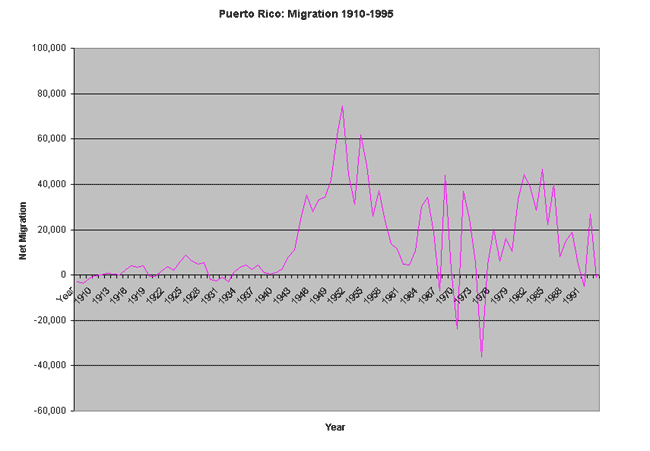|
Figures
for Yearly Migration
|
||||||||||||
|
The
government of Puerto Rico keeps track of the inflow and outflow of
people from the island. This is done by gathering
the figures for arrivals and departures at all ports and airports
of the island, month by month. When you add these figures over a period
of 12 months, the tourists cancel out and you are left with a net
migration balance, that is, the difference between departures and
arrivals. If more people left the island than the number of arrivals,
the result is a positive number which means a net balance of out-migration.
If more people arrived than left in a given year, the result is a
negative number which means that Puerto Rico received more people
that year than the number of departures.
There are advantages and disadvantages to this method of calculation. The advantage is that the government can produce yearly estimates of the net number of people leaving the island, and look at them year by year. These figures can yield a useful indication of short term fluctuations. The graph to the right indicates, for example, an extraordinary number of departures from Puerto Rico in the year 1953. We know from other estimates that the 1950s were a decade of intense out-migration from Puerto Rico.
The graph to the right was produced using figures calculated with the method described above, for the years 1910-1995. For a full explanation of the sources, go to any of the two links below.
See Table with Figures and Sources (Word Document)
See Table with Figures and Sources (HTML)
There are, however, disadvantages to this method. One disadvantage is that it lends itself to serious errors of miscalculation. For example, using that method to calculate migration balances, the Puerto Rico Planning Board came up with an estimate for the decade 1970-1980 which suggested a net in-migration balance of 300,000 people. When the figures for the Census of 1980 became available, the corrected balance was estimated at 85,000 out-migrants for the decade.[1] There are other instances in which the figures produced by the calculations based on the yearly movement of passengers have been off the mark. In recent years, these estimates have become increasingly unreliable for two reasons. The first is that the number of tourists entering the island has increased, surpassing sometimes 7,000,000 passengers in a single year. Thus, the errors in counting the number of passengers can increase in magnitude and these can affect the calculation of the migratory balance. Because the number of passengers traveling through the airports is greater than the population of the island, the potential for serious miscalculation is great.
The other reason why the estimates based on passenger movements are increasingly unreliable is the existence of a current of undocumented immigration to Puerto Rico, principally from the Dominican Republic. Many Dominican immigrants do not appear as "arrivals" because they enter the island of Puerto Rico clandestinely. However, many of them do appear as "departures" because many of them board airplanes and come to the continental United States from Puerto Rico. Although there is an immigration checkpoint at the airport in San Juan, movement between Puerto Rico and the United States is unrestricted, Puerto Ricans being citizens of the United States. The balance between arrivals and departures is affected by this unknown number of clandestine arrivals and official departures, affecting the yearly estimates of the migratory balance.[2]
Recently, Francisco Rivera Batiz and Carlos Santiago have compared the figures for migration produced by adding the yearly figures based on the movement of passengers and those calculated from the Census. They found large discrepancies in the figures. [3]
Measuring Net Migration from Puerto Rico
For this reason, when demographers calculate the migration balance by decades, they use Census figures of nativity and mortality, to produce an estimate of what the population would have been without migration, and then contrast this figure with the actual population counted in the Census. The difference constitutes the migratory balance for the decade.
[1] José L. Vázquez Calzada, La población de Puerto Rico y su trayectoria histórica (Río Piedras, P.R. : Escuela Graduada de Salud Pública, Recinto de Ciencias Médicas, Universidad de Puerto Rico, 1988), p. 284. |
Puerto Ricans | Dominicans | Colombians | Mexicans | Other Latinos | Return to Main Page
